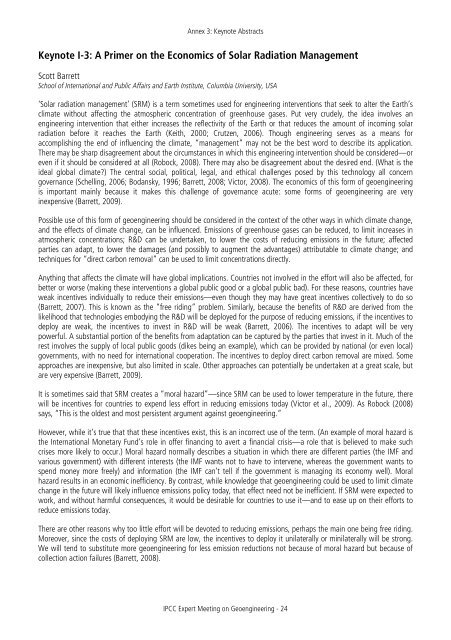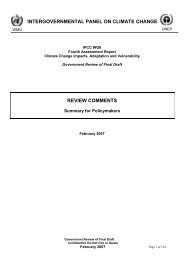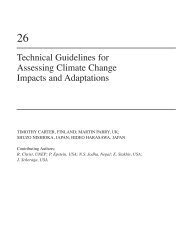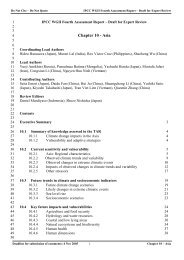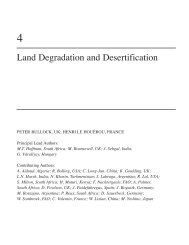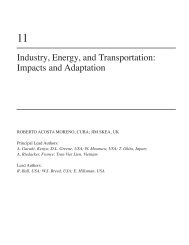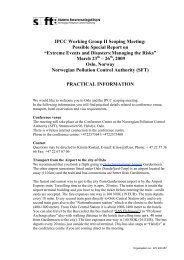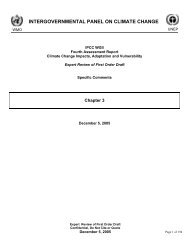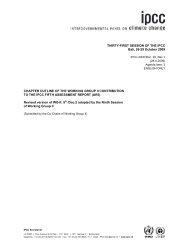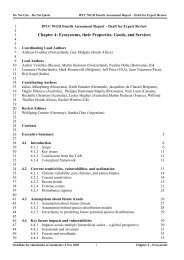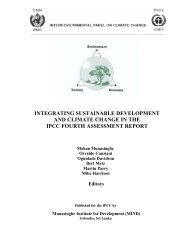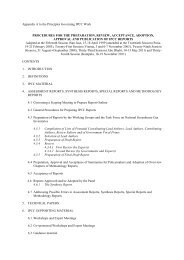IPCC Expert Meeting on Geoengineering
IPCC Expert Meeting on Geoengineering
IPCC Expert Meeting on Geoengineering
You also want an ePaper? Increase the reach of your titles
YUMPU automatically turns print PDFs into web optimized ePapers that Google loves.
Annex 3: Keynote Abstracts<br />
Keynote I-3: A Primer <strong>on</strong> the Ec<strong>on</strong>omics of Solar Radiati<strong>on</strong> Management<br />
Scott Barrett<br />
School of Internati<strong>on</strong>al and Public Affairs and Earth Institute, Columbia University, USA<br />
‘Solar radiati<strong>on</strong> management’ (SRM) is a term sometimes used for engineering interventi<strong>on</strong>s that seek to alter the Earth’s<br />
climate without affecting the atmospheric c<strong>on</strong>centrati<strong>on</strong> of greenhouse gases. Put very crudely, the idea involves an<br />
engineering interventi<strong>on</strong> that either increases the reflectivity of the Earth or that reduces the amount of incoming solar<br />
radiati<strong>on</strong> before it reaches the Earth (Keith, 2000; Crutzen, 2006). Though engineering serves as a means for<br />
accomplishing the end of influencing the climate, “management” may not be the best word to describe its applicati<strong>on</strong>.<br />
There may be sharp disagreement about the circumstances in which this engineering interventi<strong>on</strong> should be c<strong>on</strong>sidered—or<br />
even if it should be c<strong>on</strong>sidered at all (Robock, 2008). There may also be disagreement about the desired end. (What is the<br />
ideal global climate?) The central social, political, legal, and ethical challenges posed by this technology all c<strong>on</strong>cern<br />
governance (Schelling, 2006; Bodansky, 1996; Barrett, 2008; Victor, 2008). The ec<strong>on</strong>omics of this form of geoengineering<br />
is important mainly because it makes this challenge of governance acute: some forms of geoengineering are very<br />
inexpensive (Barrett, 2009).<br />
Possible use of this form of geoengineering should be c<strong>on</strong>sidered in the c<strong>on</strong>text of the other ways in which climate change,<br />
and the effects of climate change, can be influenced. Emissi<strong>on</strong>s of greenhouse gases can be reduced, to limit increases in<br />
atmospheric c<strong>on</strong>centrati<strong>on</strong>s; R&D can be undertaken, to lower the costs of reducing emissi<strong>on</strong>s in the future; affected<br />
parties can adapt, to lower the damages (and possibly to augment the advantages) attributable to climate change; and<br />
techniques for “direct carb<strong>on</strong> removal” can be used to limit c<strong>on</strong>centrati<strong>on</strong>s directly.<br />
Anything that affects the climate will have global implicati<strong>on</strong>s. Countries not involved in the effort will also be affected, for<br />
better or worse (making these interventi<strong>on</strong>s a global public good or a global public bad). For these reas<strong>on</strong>s, countries have<br />
weak incentives individually to reduce their emissi<strong>on</strong>s—even though they may have great incentives collectively to do so<br />
(Barrett, 2007). This is known as the “free riding” problem. Similarly, because the benefits of R&D are derived from the<br />
likelihood that technologies embodying the R&D will be deployed for the purpose of reducing emissi<strong>on</strong>s, if the incentives to<br />
deploy are weak, the incentives to invest in R&D will be weak (Barrett, 2006). The incentives to adapt will be very<br />
powerful. A substantial porti<strong>on</strong> of the benefits from adaptati<strong>on</strong> can be captured by the parties that invest in it. Much of the<br />
rest involves the supply of local public goods (dikes being an example), which can be provided by nati<strong>on</strong>al (or even local)<br />
governments, with no need for internati<strong>on</strong>al cooperati<strong>on</strong>. The incentives to deploy direct carb<strong>on</strong> removal are mixed. Some<br />
approaches are inexpensive, but also limited in scale. Other approaches can potentially be undertaken at a great scale, but<br />
are very expensive (Barrett, 2009).<br />
It is sometimes said that SRM creates a “moral hazard”—since SRM can be used to lower temperature in the future, there<br />
will be incentives for countries to expend less effort in reducing emissi<strong>on</strong>s today (Victor et al., 2009). As Robock (2008)<br />
says, “This is the oldest and most persistent argument against geoengineering.”<br />
However, while it’s true that that these incentives exist, this is an incorrect use of the term. (An example of moral hazard is<br />
the Internati<strong>on</strong>al M<strong>on</strong>etary Fund’s role in offer financing to avert a financial crisis—a role that is believed to make such<br />
crises more likely to occur.) Moral hazard normally describes a situati<strong>on</strong> in which there are different parties (the IMF and<br />
various government) with different interests (the IMF wants not to have to intervene, whereas the government wants to<br />
spend m<strong>on</strong>ey more freely) and informati<strong>on</strong> (the IMF can’t tell if the government is managing its ec<strong>on</strong>omy well). Moral<br />
hazard results in an ec<strong>on</strong>omic inefficiency. By c<strong>on</strong>trast, while knowledge that geoengineering could be used to limit climate<br />
change in the future will likely influence emissi<strong>on</strong>s policy today, that effect need not be inefficient. If SRM were expected to<br />
work, and without harmful c<strong>on</strong>sequences, it would be desirable for countries to use it—and to ease up <strong>on</strong> their efforts to<br />
reduce emissi<strong>on</strong>s today.<br />
There are other reas<strong>on</strong>s why too little effort will be devoted to reducing emissi<strong>on</strong>s, perhaps the main <strong>on</strong>e being free riding.<br />
Moreover, since the costs of deploying SRM are low, the incentives to deploy it unilaterally or minilaterally will be str<strong>on</strong>g.<br />
We will tend to substitute more geoengineering for less emissi<strong>on</strong> reducti<strong>on</strong>s not because of moral hazard but because of<br />
collecti<strong>on</strong> acti<strong>on</strong> failures (Barrett, 2008).<br />
<str<strong>on</strong>g>IPCC</str<strong>on</strong>g> <str<strong>on</strong>g>Expert</str<strong>on</strong>g> <str<strong>on</strong>g>Meeting</str<strong>on</strong>g> <strong>on</strong> <strong>Geoengineering</strong> - 24


